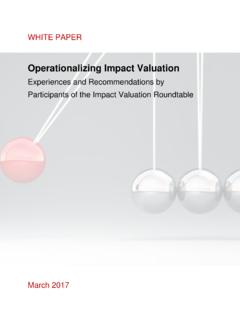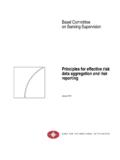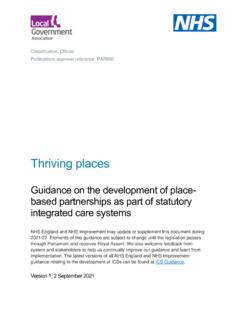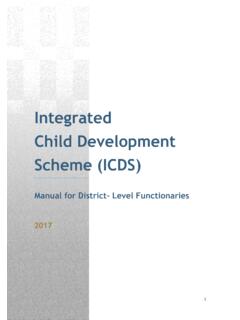Transcription of ESG Disclosure Handbook
1 ESG Disclosure Handbook2 ESG Disclosure Handbook ESG Disclosure Handbook 3 Contents1. Foreword42. ESG Disclosure Handbook Purpose and objectives5 Introduction5 What is the ESG Disclosure Handbook and who is it for?5 Why is this Handbook needed?6 How to use the handbook7 Structure of the handbook8 How the Handbook fits into the corporate reporting landscape 83. Process overview104. Key questions11 Key question 1: why report ESG information?11 Key question 2: for whom should ESG information be reported? 13 Key question 3: where should ESG information be reported?15 Key question 4: what ESG information should be reported?16 Key question 5: how should ESG information be prepared and presented?18 Key question 6: how much ESG information should be reported?205. Steps in the evaluation process24 A: Evaluate24 B: Decide26 C: Document266. Handbook checklist287. Endnotes294 ESG Disclosure Handbook1. ForewordThe burgeoning interest in corporate environmental, social and governance (ESG) information from investors, society, central bankers and others has led to welcome developments in reporting frameworks, codes, rules and practices.
2 The reporting Exchange records almost 2,000 reporting provisions and other resources that directly or indirectly affect the way in which companies report on ESG matters. While these developments are welcome responses to the challenges of our times, they also mean that companies are facing many choices when deciding what ESG information to report, how, to whom and where. The Corporate reporting Dialogue (CRD) brings together some of the most influential developers of ESG reporting frameworks and standards. The CRD is a response to market demand for greater coherence, consistency and comparability between different frameworks. Members are committed to driving better alignment of sustainability reporting frameworks, as well as with frameworks that promote further integration between non-financial and financial reporting . As Chair of the CRD, I welcome the ESG Disclosure Handbook . It is a valuable resource for companies aiming to evaluate the way in which they may use different reporting frameworks and standards to achieve effective and purpose-driven Disclosure .
3 The Handbook adopts relevant principles from the professional frameworks that accountants use when making and assessing significant judgments and providing useful input into ESG Disclosure decisions. By providing a structured evaluation process, the ESG Disclosure Handbook makes an important contribution to enhancing ESG Disclosure . Ian Mackintosh, Chair, Corporate reporting Dialogue ESG Disclosure Handbook 52. ESG Disclosure Handbook purpose and objectivesIntroductionMany considerations affect the decisions companies make about what environmental, social and governance (ESG) information they report as well as how and where they should report the information and for which audiences. The regulatory and societal context in which the company operates, its stakeholders, ethical choices and values and other factors influence the choices about what to report. The absence of universally agreed objectives, standards and thresholds for external ESG information Disclosure means that reporting takes place against a background of uncertainty.
4 Risks can arise from the failure to satisfy stakeholders information needs, perceptions of lack of accountability and disconnects between information reported through different channels. Companies therefore adopt various approaches to ESG reporting in practice. These include: Publishing multiple reports aimed respectively at particular subject matter, themes, objectives or framework requirements; integrated reporting that aims to cover all subject matter materially relevant to performance and value creation, including increasing the presentation of ESG information alongside financial statements and management commentary;1 Hybrid approaches based on a range of influences, including reporting requirements, internal objectives, peer practice and/or targets for inclusion in indices. All of these approaches are legitimate responses to the demand for ESG information. However, in many cases it is difficult for users of information to discern why a company has taken a particular approach, what assumptions inform conclusions about the ESG information reported, and what purpose and audience the information intends to is the ESG Disclosure Handbook and who is it for?
5 The ESG Disclosure Handbook offers guidance to help companies navigate choices associated with ESG reporting , including: The ESG information needs of multiple stakeholders; Multiple reporting provisions (see Box 1); Internal objectives for reporting ; External objectives for reporting ( , measuring impact, compliance, etc.); Concerns about reporting volume and clutter obscuring important guidance in the ESG Disclosure Handbook is designed for use by companies when considering what to report, where, why, to whom and how in response to non-prescriptive mandatory ESG reporting requirements (see Box 1), voluntary ESG reporting requirements and corporate ESG reporting objectives. The guidance is a structured evaluation process to help companies address the multiple considerations that inform external ESG reporting decisions. The structured evaluation process is made up of six key questions and three process steps as described in sections 4 and 5. 6 ESG Disclosure HandbookWhy is this Handbook needed?
6 Decisions about the type of ESG information to report as well as why and how companies should prepare the information, where they should report it and for whom, are based on the evaluations and judgements management makes when assessing the different options available to them. As ESG reporting requirements evolve, become more complex and add new features, such as the demand for forward-looking, investor-grade information, companies will increasingly need techniques to respond to new reporting challenges. The ESG Disclosure Handbook provides a structured process to exercise judgement when forming balanced and supportable opinions about the options and inputs available during the ESG reporting decision-making process. Judgement is not the same as decision-making. Judgement is a skill that applies where there is more than one potentially correct answer. Judgement leads to the forming of opinions and is a subset of decision-making. The objectives of judgement are to: Achieve independence and help avoid biases; Support comprehensive fact-gathering and documentation; Evaluate different options; Limit errors and risks; Improve the quality of information through discernment; Support assurance activity; Raise confidence in reported information; Enhance coherence between ESG and other corporate information; Help the board and audit committees understand the options management is considering and the approach taken to reach decisions about external ESG information accounting profession uses judgement frameworks to guide accountants and others when making, assessing and documenting significant As ESG reporting adopts more of the characteristics of financial reporting and demands for transparency on the assumptions reporting companies make increase, professional judgement frameworks applicable to accounting provide useful input into ESG Disclosure decision-making.
7 Box 1: reporting provisions: introducing the reporting Exchange and the Indicator LibraryA reporting provision is a legal/mandatory requirement or a voluntary framework, code or guidance document that provides details of what a company must do or could do to provide ESG information in external reporting provisions can be prescriptive telling the reporting company exactly what they must do or non-prescriptive. Non-prescriptive mandatory reporting requirements are legal requirements for the provision of general ESG information that do not prescribe the exact content. For example, Article of EU Directive 2014/95/EU requires certain companies to include a non-financial statement containing information relating to environmental, social and employee matters, respect for human rights, anti-corruption and bribery matters in the management report. However, it does not prescribe the exact content; therefore, companies have to use judgement and discretion about how to reporting Exchange and Indicator Library are resources designed to help companies understand and navigate ESG reporting reporting Exchange ( ) is an online platform that records details of reporting provisions that directly or indirectly influence the way in which companies report ESG information.
8 reporting provisions are recorded on the reporting Exchange where they are introduced, developed or can be interpreted to support ESG and sustainability reporting and non-financial Disclosure requirements. Within the reporting Exchange, the Indicator Library identifies certain indicators specified in some of the provisions recorded. The purpose of the Indicator Library is to organize, categorize and structure within a central resource some of the indicators that companies commonly use for external reporting . The way in which the Indicator Library organizes and structures provisions and indicators does not apply any value judgement as to the merits, relevance or usefulness of indicators they are simply recorded according to an agreed categorization structure with full referencing back to the source of the indicator. The reporting Exchange and the Indicator Library should be used in conjunction with the ESG Disclosure Handbook as a reference point for companies when exercising their judgement about what to disclose in external reports.
9 ESG Disclosure Handbook 7 How to use the handbookCompanies may use the Handbook to: Explore the various options associated with external ESG Disclosure ; Inform the development of a reporting strategy and external Disclosure processes. A reporting strategy is a plan of action and a decision-making framework designed to achieve reporting objectives and ensure that information is decision-useful. It enables teams and people involved in the reporting process to understand and coalesce around the company s strategic reporting approach. It is likely to include details of: Operational and organizational reporting boundaries; The standards and methodologies that the company will use to prepare ESG information; Third party or company-created definitions of ESG terminology; The circumstances in which companies will seek external assurance; The timescales over which companies will report information, including the company s definition of short-, medium- and long-term; The perspectives from which the company will report information; Systems and internal controls for collecting ESG information; Sign-off procedures for ESG information.
10 Work through the structured process outlined in section 3 and explained in more detail in sections 4 and 5; Identify the most appropriate reporting provisions and indicators to use in conjunction with the reporting Exchange and Indicator Library (see Box 1); Take control of the company s narrative within corporate reports to limit or balance opinions and conclusions reached by investors and others based on a variety of information sources; Support collaboration, knowledge sharing and cross-functional, interdisciplinary team discussions and/or regular meetings with professionals from finance, risk management, control and planning, investor relations, legal, sustainability and communications departments; Understand more about user information needs; Reference in external reporting to explain the approach used when preparing disclosures about judgement. Where management has used the Handbook to guide decision-making on external ESG reporting , they can state that their ESG reporting decisions have been based wholly or partly (as appropriate) on the ESG Disclosure information needsThe ESG Disclosure Handbook provides insights into the information needs of investors.














